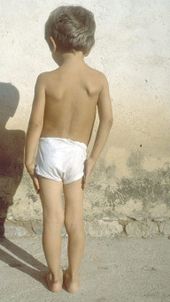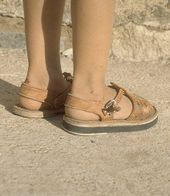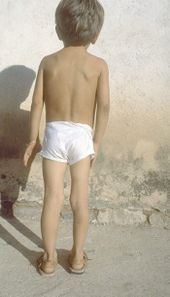Hesperian Health Guides
What to Do
HealthWiki > Disabled Village Children > Chapter 20: Spinal Curve and Other Back Deformities > What to Do
This will depend on:
- how severe the curve is.
- if it is getting worse—and if so, how quickly.
- whether the curve is fixed.
- the age of the child.
How severe the curve is and whether it is getting worse can be best measured by X-rays.
| 1. For each curve, pick the 2 vertebrae that tilt most in relation to each other. |  |
| 2. Draw lines level with the top of each vertebra. |
 |
3. Measure and record the angle of the spinal curve. |  |
| 4. Regularly record the curve and notice any changes. |
Because X-rays are expensive and often hard to get, you can get some idea of whether the curve is getting worse by measuring the angle of the rib hump.
| Be sure the top piece is completely level. You can use a carpenter’s level or a homemade one (see box). |
 |
Measure this angle. |
 | ||
| Have the child stand or sit as straight as possible, while he bends forward. | ||
If the rib hump angle stays about the same month after month, the curve is probably not getting worse. Keep checking it every few months. If the rib hump angle increases steadily, the curve is getting worse. X-rays should be taken and a decision made about what to do.
Non-fixed curves that are not getting worse should usually be treated only by doing something about the underlying condition.
For example, if the child’s spinal curve is not fixed and comes from a hip tilt due to unequal leg length:
 Measure the difference in leg length. |
 Level the hips by standing on books or boards. |
 Put a lift on shoe or sandal. |
 |
 |
 |
| This child was developing a spinal curve due to hip tilt and short leg. | Village rehabilitation workers put a lift on his sandal. | This corrected his spinal curve and lop-sided posture. |
| Body jackets or bracing for a non-fixed curve usually do not help to correct the curve or even to prevent its getting worse. However, for a child with a curve so severe that it makes sitting or walking difficult, a body jacket or corset may help. |  |
 |
See instructions for making body jackets. |
| Spinal curves under 20° (fixed or non-fixed) usually need only to be watched and measured every few months to see if they are getting worse. |  | |||
| Some experts say that exercises to strengthen the back muscles, like this, help correct and slow down the curving of the spine. Other experts say it does no good. (We do not know.) |  | |||
| Spinal curves over 20°, if they are fixed and getting worse, may get worse less quickly with a brace. | ||||
| A brace like this (the Milwaukee brace) is often used. It works because it is so uncomfortable that the child must stretch his body as straight as possible to reduce the discomfort. |  |
A plastic Boston brace like this is more comfortable, can be completely hidden under the clothes, and probably does as much good. |  |
|
SURGERY
For spinal curves over 50° which are quickly getting worse, surgery may be needed. Surgery fuses (joins together) the most affected vertebrae. Usually it only partly straightens the spine. Except for very severe curves, surgery should be avoided in children under 12 years old because the fused part of the spine will not grow any more.
If the curve of the spine is less than 40° by the time the child stops growing, usually it will not progress further. If the curve is over 50°, it is likely to keep getting worse even after the child stops growing, and surgery is often recommended.
However, spinal fusion surgery is very costly and requires an orthopedic surgeon specially trained in this operation. It can also be very hard on the child and family. When surgery cannot be obtained, a body jacket or brace should perhaps be used to help slow down the curve’s progress. When a curve becomes too severe, there is no longer enough room in the chest for the lungs and heart to work well, and the child may get pneumonia and die.
EXERCISES FOR ROUNDED BACK AND SWAYBACK
| Children with rounded back may benefit from exercises to help straighten it, like this. | The child should also be encouraged to sit and stand as straight as possible, with the shoulders back. | ||
 |
These exercises are explained in the Exercise Sheet #5. |
 |
 |
| The child should also be encouraged to sit and stand as straight as possible, with the shoulders back. | or by exercises to correct hip contractures (if the child has them). See Exercise Sheet #3. |





